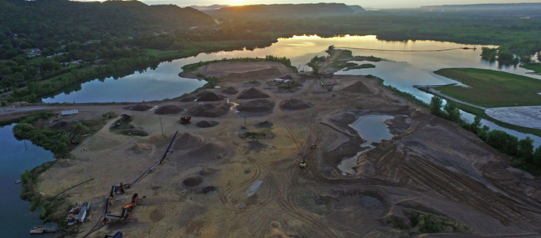 photo credit: Kendahl Schlueter, Winona Daily News
photo credit: Kendahl Schlueter, Winona Daily News
The Minnesota Environmental Partnership is proud to feature the following post as part of our Student Voices Series. This is part of a continuing collaboration with Macalester College’s Geography Department and its students. The following column was contributed by Kaitlyn Lindaman and represents her views.
Fracking took hold of Winona in 2010.
On a warm summer day in 2010, I was on my usual four-mile running route in Winona. This route crossed a creek by bridge and then followed a back road along the marshes and other small ponds, under the shade of trees and on relatively flat elevation next to the bluffs. I often encountered turtles making their way across the road, who only had to watch out for the occasional bikers and runners.
Then I began to notice fracking. Suddenly there were large trucks, nearly pushing me off the side of the road and I was accumulating sand in my shoes. Soon the turtles disappeared too.
Frac sand mining extracts silica sand, mined from sandstone formations, for the future use in oil and natural gas hydraulic fracturing operations. With its pristine bluffs, deposits of the sand, and the Mississippi River wide and deep enough for barges to pass through it, Winona is an enticing location for fracking sand companies. Furthermore, the operations require the input of water, so marshes and other lakes fell victim, as they were up for grabs in some areas of Winona County. Large trucks began to erode the roads, leaving gapping holes, with dust covering the air and the booming noise of trucks.
The community took notice too. Operations ramped up as did destruction of the area until 2015 when oil prices began to decline and the popularity of fracking waned with it. At this point, the community was becoming increasingly unsettled with their newest neighbor.
Due to the destruction of scenic bluffs along the Mississippi River, health concerns from the blowing silica sand dust, contamination of groundwater, and damage to roads, it became apparent that some action needed to be taken. With high community pushback against fracking, the Winona County Board moved to ban the operations. Nearly 70% of the community supported this trajectory. In late 2016, Commissioners voted 3-2 in favor of the ban.
This was a great victory for the residents of the County, as we were one of the first to ban to such operations, further demonstrating the influence that public comments and resistance can have in shaping a community. However, Minnesota Sands, the main silica sand company, is relentless in their efforts to continue their operations. They claim to hold leases or interests to $3.6 billion in frac sand deposits within the county borders. In November 2017, Winona County District Court Judge Mary Leahy ruled in favor of the county, ruling that “the wide variety of evidence presented to the county amply supports the county’s actions” going on to add that “the county determined there were several unique characteristics to industrial mineral mining that could be hazardous to the county in a way entirely different from construction mineral mines”.
While our victory has been upheld in Winona County, Minnesota Sands looks to nearby Fillmore County as a back up option. When the company first laid down routes in the area they proposed 11 mines in Winona, Fillmore, and Houston counties. So far, Winona is the only one that has put bans on fracking. The company initially promised to conduct an Environmental Impact Statement (EIS) to analyze the environmental effects of their proposed mines. They have yet to follow through on this, evidence of their negligence to the area and community.
While wrapped up in court cases late last year, the company simultaneously asked the state Environmental Quality Board (EQB) to release it from the EIS requirements so that it could move forward with mining at its Fillmore County site. The EQB has refused to act until the Winona County case was resolved. State regulators were expected to review the issue again this past March, but have yet to do so.
With the obvious lack of care and unacceptable absence of an EIS, members of Fillmore County would be wise to put pressure on their Commissioners to follow Winona County lead. Furthermore, the EQB should protect counties from large, corporate interests and back local decisions. At the very least, Minnesota Sands should not be allowed to proceed before the completion of an EIS. The community can get involved by putting pressure on the EQB and potentially go as far as to petition for an EIS to occur.
We thought our fracking trouble would soon be behind us in Southeast Minnesota. I urge you to continue to pay attention to what is going on in your backyard. Winona County needs to continue to maintain the ban, and should support our county neighbors. Then, after our fight is finally over, hopefully we can eventually return to runs along the bluff, with the occasional turtle spotting.